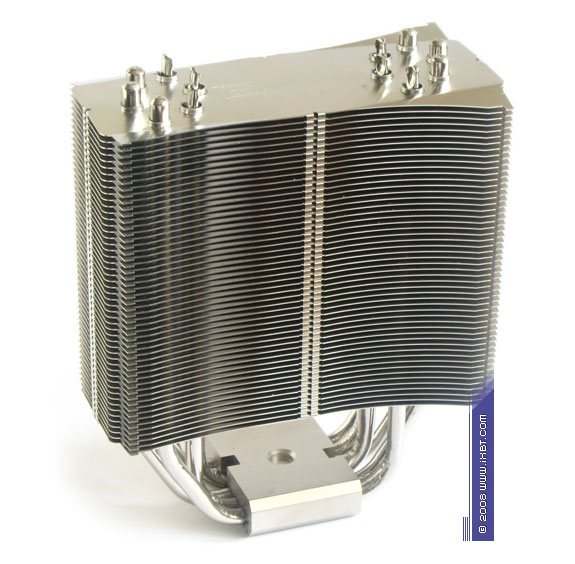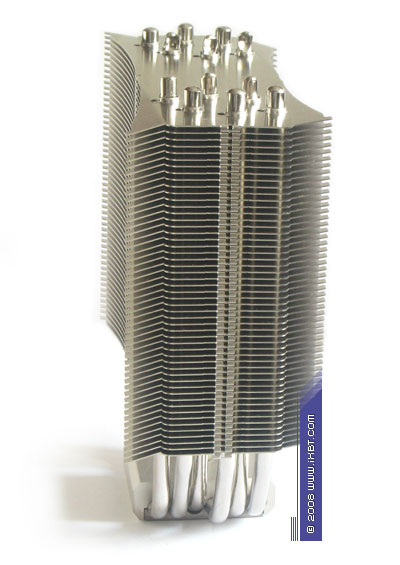We continue our series of reviews of advanced cooling systems. Today we are going to examine two High-End coolers from Thermalright - Ultra-120 eXtreme and Ultima-90. In fact, both products are hardly the latest offers. They were rolled out long ago and had enough time to earn users' respect. The main Thermalright customers actually live in Europe and America.
And now let's proceed to the analysis of technical properties of our today's High-End contenders - Ultra-120 eXtreme and Ultima-90.
Ultra-120 eXtreme
The first cooler to examine is Ultra-120 eXtreme - the brightest representative of vanguard cooling systems of extra class from Thermalright. Indeed, the cooler deserves its ultra and extreme titles in technical terms - the working medium consists of a copper base (39x42x5 mm), six copper heat pipes (6 mm in diameter), and a large aluminum fin-stack (130x64x115 mm), which offers truly advanced thermal characteristics.
The main achievement of this cooler is an efficient merger of two mutually exclusive approaches - extensive and intensive. Here is the extensive side: a powerful fin-stack (52 fins, 0.3 mm thick, total heat exchange surface area - 7500 cm2) and six heat pipes that provide an advanced thermal crown for the base and form 12 heat release elements. That is they are typical technical solutions in the spirit of maximalism - the more and cooler, the better.

The intensive part of Ultra-120 eXtreme looks much more interesting. First of all, note interesting bends of peripheral fins, which direct the air flow. They provide a small displacement vector towards the central part of the fin-stack for more active ventilation of the heat sink. The heat release elements are also grouped in a very interesting way - not three in a row (the standard layout of heat pipes), but in a circle, they are not standing in each other's way as far as inner air flows are concerned, so they help minimize hydraulic resistance of the fin-stack.
Geometry of the fins is also quite illustrative. They have a concave edge to narrow down the "passage zone" in the center of the fin-stack (fins are only 48 mm wide here versus 60 mm at the periphery), which compensates the tight fin step (2 mm) and moves the fan from the flat end of the heat sink for more pronounced generation of an air stream in the center of the fin-stack and better acoustic matching.

Another important element in the image of Ultra-120 eXtreme is good contact between the heat pipes, the base, and the fin-stack. Many cooler builders pay little attention to these technical details, especially what concerns connecting pipes with fins, which are usually joined "dry" (or with thermal glue) without providing necessary minimization of thermal resistance in the place of contact. This product has no problems with that - all heat pipe joints are neatly soldered, to guarantee efficient heat removal (base-pipes) and just as efficient heat release (pipes-fins). In this connection we want to point out one interesting fact - Thermalright always uses soldering as the only true method of thermomechanical contact, it has been using it since the first coolers with heat pipes for AMD Socket A. So it's high time for some brands to adopt the positive experience of their elder competitors instead of stubbornly saving on technologies.
If we leave the purely technical field for usability, Ultra-120 eXtreme is not as good as we'd like it to be. In fact, we have no gripes with the installation procedure - it comes with a reasonable multi-platform retention module that ensures easy and simple installation. Indeed, you don't have to screw anything to the heat sink or assemble any cunning retention modules on a motherboard. In order to install Ultra-120 eXtreme, you just use four spring-loaded screws to mount a special bracket and a backplate for Intel LGA775 or a special bracket and the reference backplate for AMD Socket AM2. However, a motherboard must be removed from a PC case in both cases, but this procedure can rarely be avoided with large High-End coolers.

Meanwhile, the consumer image of Ultra-120 eXtreme is spoilt by its scarce, even ascetic bundle - the bundle lacks a fan. I understand that the cooler is positioned as a construction kit - you get a heat sink and you find a proper fan to your liking. But taking into account the retail price tag of Ultra-120 eXtreme, a fan wouldn't have made it any more expensive. They could have bundled at least a mediocre fan for initial tests.
Besides, the installation process for an optional fan is also confusing: configuration of local brackets is not very convenient (especially the way they are attached to the heat sink). Besides, a fan won't sit tight even with the bundled shock-absorbing spacers - there will be some backlash. Another problem is the limited number of these brackets - the bundle includes only two of them, strictly for a single fan. That is, you can forget about dual-fan assemblies of Ultra-120 eXtreme, if you don't want to use extra accessories. The bundled thermal compound also looks too plain (for a premium product) - it comes in a syringe with a brand label, all right, but it has a typical composition (standard organosilicone compound of mediocre quality). As a result, overall usability of this product is disappointing rather than inspiring. So it will be up to users to raise these aspects to the truly High-End level.

OK, we've sorted out the situation with technical properties and usability of the top Ultra-120 eXtreme cooler. Now it's time to examine another contender - Thermalright Ultima-90.
Write a comment below. No registration needed!






